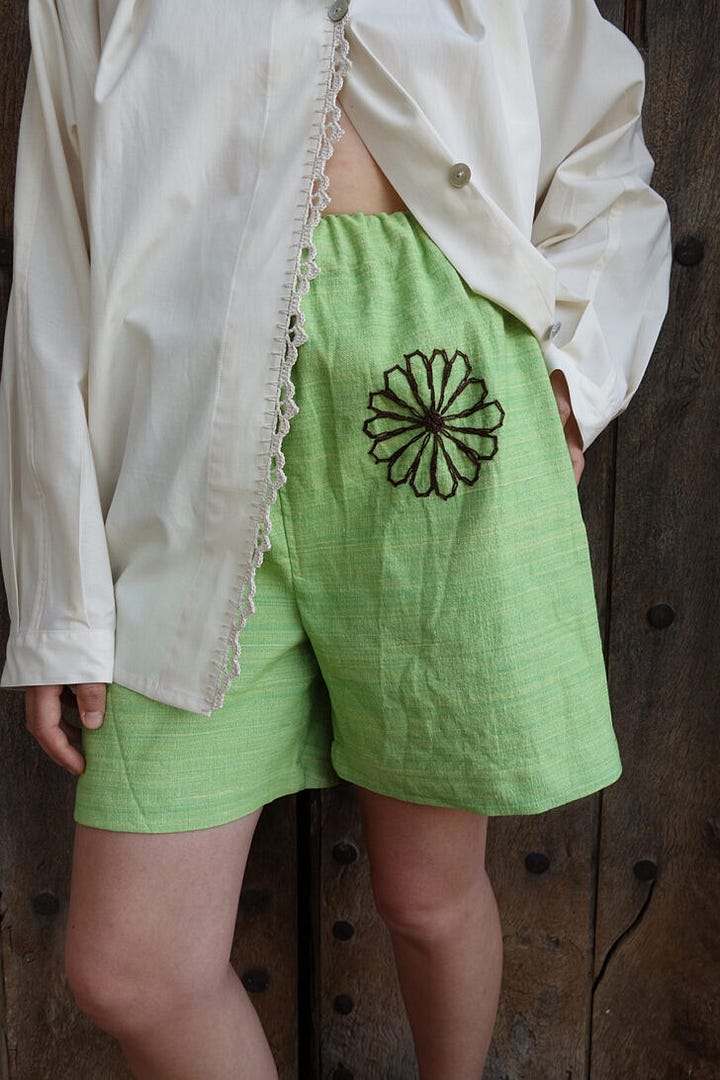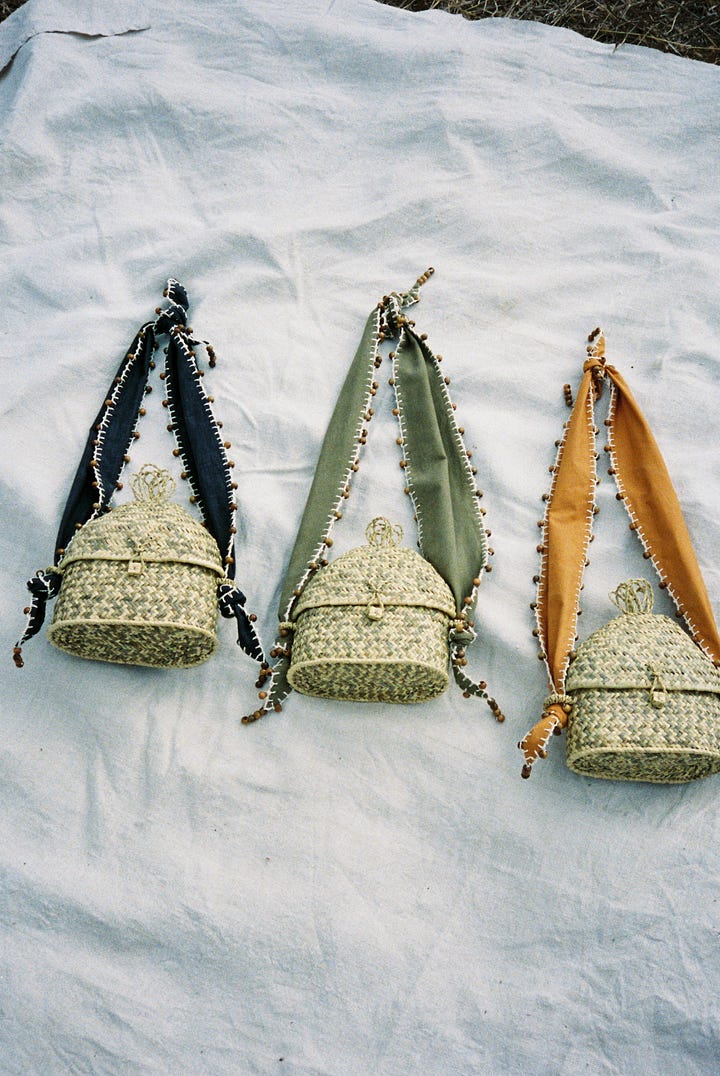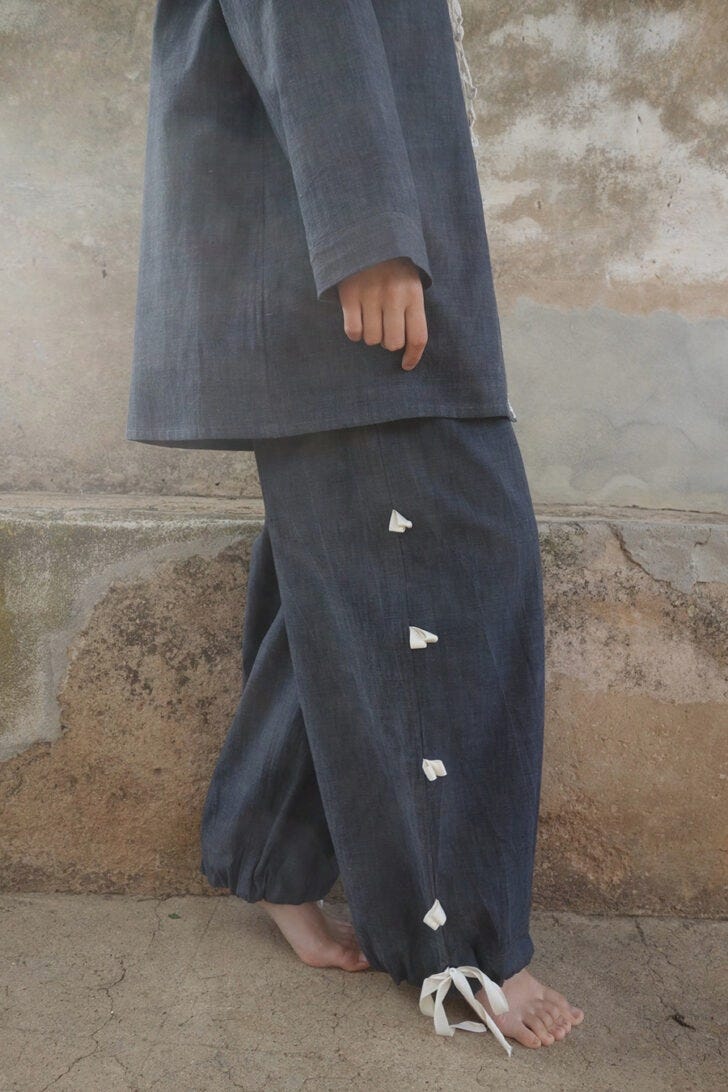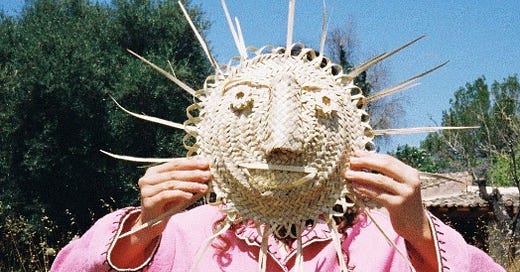Hotter than a Spanish Summer Sun
Introducing Accidente con Flores, with founders Ola Kawalko and Adrián Martínez Marí
All enigmas and marketing aside, clothes are portable shelters. We make and wear them to protect us from the elements: cold, heat, rain, and wind — and, in some cases, UV rays, dust, and natural hazards.
That’s why there are different clothes for different seasons. (But not why there’s a seasonal fashion cycle, by the way — that’s a recent invention.) And that’s why you usually wear linen in summer and wool in winter.
It’s also why some fashion scholars wonder: are we “inside” our clothes, or is our clothing somehow an extension of our body — in the same way telescopes and microscopes are extensions of our eyes?

Accidente con Flores, a creative studio founded in 2017 by Adrián Martínez Marí and Ola Kawalko — a former member of Haider Ackermann’s design team — forms an interesting exception to all this. Of course, their clothes and accessories are perfectly adapted to their place of origin: Mallorca, one of Spain’s Balearic Islands in the Mediterranean Sea, known for its white beaches, sheltered coves, limestone mountains, and Roman and Moorish remains.
But that’s beside the point.
And the same holds for how Accidente con Flores’s shirts, pants, bags, rugs, and ceramics are made. Everything is as environmentally conscious, sustainable, and socially responsible as can be. The pieces are designed, cut, and sewn in their own atelier. The production takes place on the island, in collaboration with local suppliers and carried out by the expert hands of local artisans. The fibers are natural and GOTS-certified organic, and often handspun from Mallorcan yarns.
No surprise there, in a way.
Look at the images, and you’ll immediately see something else is going on. These clothes don’t simply offer protection from the sun, they’re a natural extension of it. They’re not made for the summer, they’re summer incarnate. They exist like blistering 3 p.m. Spanish sunbeams woven into a super fine fabric. You don’t wear them to shelter from anything. You wear them to immerse yourself completely, to embody what’s said to be outside yourself. It’s mostly womenswear, yes, but what does gender matter when it’s really hot — just size way up or else buy it as a gift for someone you love.




This way of looking at what we wear might sit better with our need to inhabit, rather than protect ourselves from, the Earth. And it might make perfect sense at a moment in time when it’s not just us people taking shelter from the world, but the world sheltering from us.
Perhaps.
There’s not doubt at any rate that it harmonizes with Adrián’s and Ola’s holistic approach to clothes, which for them are by-products of a larger artistic practice that, in turn, flows naturally from their own “life-process.” It means there’s never a definite beginning nor a definite end to their work, and every piece takes shape independently, as the temporary material outcome of their personal experiences, inspirations, feelings, and emotions.
That sentence may seem due to heatstroke. I’m pretty sure it isn’t. It’s what happens when Accidente con Flores begins to really catch on. In my case, that began a few months ago, when I first reached out to Adrián and Ola with a couple of questions. “We haven’t found the time to answer them yet — they are detailed and require deep thought,” they wrote some weeks later. “We will try to sit with them this summer.” How fitting!
How did Accidente con Flores start, and how has it grown since 2017?
We met in 2014 in Antwerp where Ola was studying fashion design at the Royal Academy. I had moved there to focus on my artistic career after graduating from the Academy of Fine Arts in Tenerife. We got together as a couple and continued collaborating professionally, alongside pursuing our individual careers. From the start we felt that we wanted to work together and create our own independent multi-disciplinary design studio.
Because of our previous experience, Accidente con flores started with clothes, but from the very beginning we looked at it as something much broader in scope. Shortly after moving to Ibiza, we began collaborating with local artisans and started offering ceramic pieces made in collaboration with various local ceramicists. After three years of creating, learning, and making connections in Ibiza, we decided to move to the bigger island of Mallorca, where crafts and traditional techniques are ever richer and of exceptionally high quality. We discovered amazing artisans — all masters in their fields, including textile weaving, glass blowing, palm weaving, wool felting, natural dyeing, ceramic making, metal work and much more. Our interest in locally made pieces grew and it soon became an essential part of our permanent collection.
As said, we’d always wanted to create a space where we would be able to connect with people through our designs and also serve the local community. We believe that a creative and friendly community is very, very important today.
You regularly work with local artisans, and have also started a nonprofit project — called How They Work — that aims to bring together creative artists from all over the Spanish Balearic Islands. I’m curious to hear how such collaborations typically take shape in practice.
Well, first of all, we do not force and try to get the material we want to work with. We rather start from what is available and then begin to think what we can make out of it. We are very lucky to have all of those creative, talented people around us. And we love to work alongside and learn from them.
We especially feel close to local artisans working with Mallorcan sheep. We connected early on and grew together, inspiring and pushing each other forward. As their knowledge of the spinning and felting of local wool increased, we were able to develop an entire series of wool products together.
Each collaboration will look differently. With some artisans we are more specific in what we have in mind. With others we really co-create. But we always give them a lot of freedom and we really rely on their expertise. There are always so many technical details and issues, and they know much better how to deal with them than we do. It is important for us that they feel inspired, respected and, of course, well-paid for their work.

Fashion is known to experience a significant amount of sustainability or climate fatigue, not in the last place because of global brands’ continuous greenwashing. How do you think Accidente con Flores is contributing to making sure sustainability upholds its meaning and significance?
We try to be as truthful and transparent as possible to our customers. We always specify in detail how the piece they are ordering was made. With most of our products we can be very specific, in this regard. This applies to everything from the fiber and the shepherd to the spinner, weaver, dyer, tailor, and the group of ladies that’s doing our hand embroidered and hand crocheted pieces.
We produce on a relatively small scale, at our own slow pace and from a position of total freedom. These things allow us to take the time that’s necessary to develop practices that are really sustainable and create products that align with our priorities and values.




And do you ever have to make compromises?
Yes, we do. There are no local manufacturers in Mallorca that offer organic textiles, for instance. This means we have to source them abroad. There are three small, very old and family-run local ateliers weaving beautiful linens and cottons on traditional looms, though. They are doing amazing work, keeping the tradition alive, and their fabrics are stunning. It’s very important to us to support them. It’s very hard to keep everything local and organic, especially on such a small island. But we believe everyone here is doing their best, and we’re supporting wherever we can.
I’m wondering how you look at the relation between local production and global distribution. Do you see a tension here?
We decided to sell our products mainly from our own website and not work with worldwide stockists. This for two reasons. The first has to do with pace and mass production. Most of the stores work in a certain tempo, requiring two collections a year, with deliveries shipped one year in advance, produced in relatively big quantities. We do not want to be part of that system. Second, selling to and at stores means working with wholesale prices. This would double our current pricing point and make our products at least twice as expensive for customers. That’s not what we want. We like to offer our pieces for reasonable and fair prices.
Lastly, some sort of (false?) dilemma: making slowly made, artisanal products as widely available as possible — compromising on quality if need be — or sticking to principles and accept that they’ll remain relatively exclusive?
We believe most people do not have enough knowledge of how the clothing they wear gets made. We live in a world where shirts for five euro’s have become normalized. There is definitely still a lack of consciousness when it comes to the impact this kind of practice has on people and the planet.
The bottom line is that we do not need a new pair of pants every other month. It’s better to buy one pair a year, say, that’s made ethically and directly supports the person behind it. Besides, you’ll cherish it more, you will take care of it, and it will become part of your life. The question, of course, is how to put this in practice.

I know it might sound naive but the way forward is to look back, in a sense. People used to invest in clothes, shoes, baskets, etc., made by tailors, shoemakers and artisans. They were buying much less and what they bought was of much higher quality.
It’s simply not fair to expect skillful artisans who take pride in what they do while taking care of their local environment to lower their prices. They already earn very low wages. Many of them cannot even make a living out of it. We need to change, not them.




